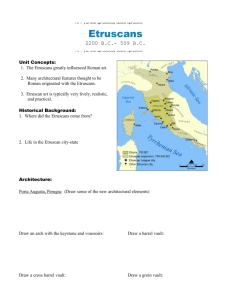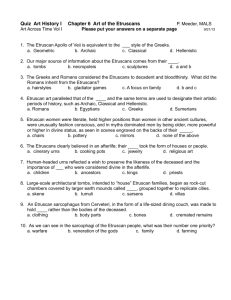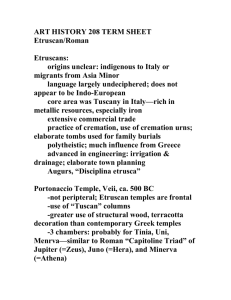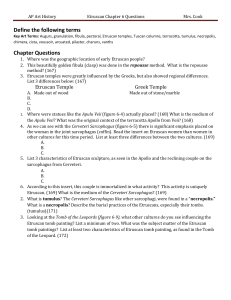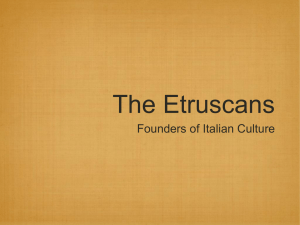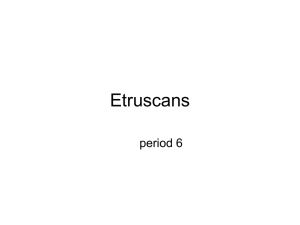Key Terms
advertisement
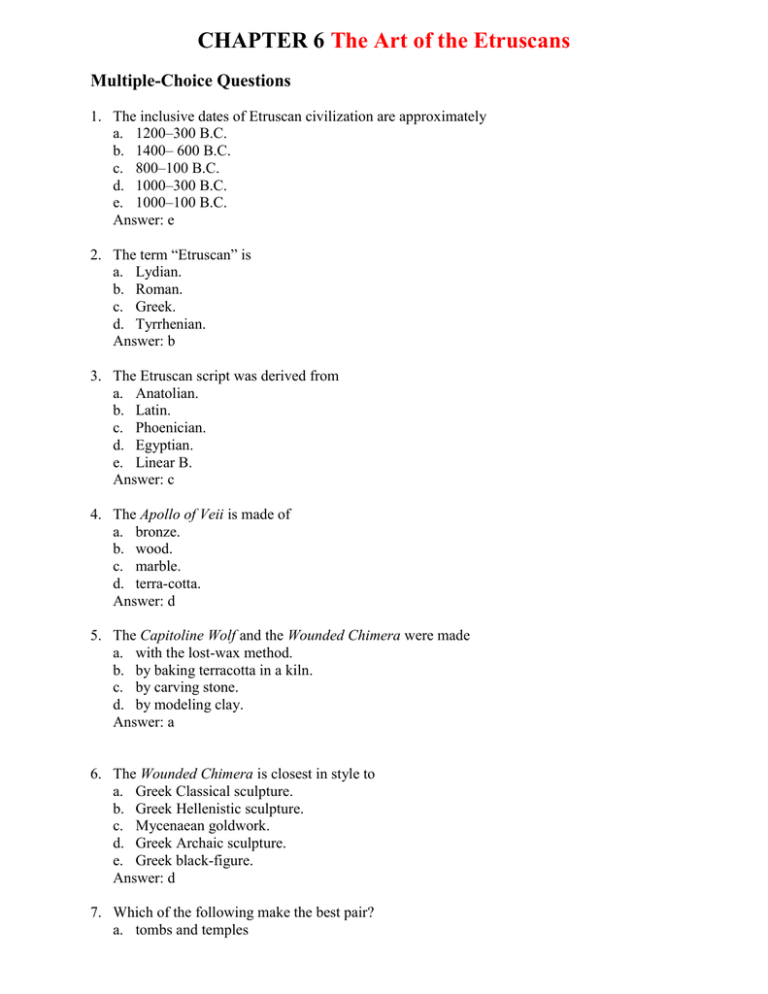
CHAPTER 6 The Art of the Etruscans Multiple-Choice Questions 1. The inclusive dates of Etruscan civilization are approximately a. 1200–300 B.C. b. 1400– 600 B.C. c. 800–100 B.C. d. 1000–300 B.C. e. 1000–100 B.C. Answer: e 2. The term “Etruscan” is a. Lydian. b. Roman. c. Greek. d. Tyrrhenian. Answer: b 3. The Etruscan script was derived from a. Anatolian. b. Latin. c. Phoenician. d. Egyptian. e. Linear B. Answer: c 4. The Apollo of Veii is made of a. bronze. b. wood. c. marble. d. terra-cotta. Answer: d 5. The Capitoline Wolf and the Wounded Chimera were made a. with the lost-wax method. b. by baking terracotta in a kiln. c. by carving stone. d. by modeling clay. Answer: a 6. The Wounded Chimera is closest in style to a. Greek Classical sculpture. b. Greek Hellenistic sculpture. c. Mycenaean goldwork. d. Greek Archaic sculpture. e. Greek black-figure. Answer: d 7. Which of the following make the best pair? a. tombs and temples b. mirrors and media c. urns and sarcophagi d. frescoes and finials Answer: c 8. Which of the following is NOT a correct match between the Etruscan and the Greek? a. Hera and Herakles b. Uni and Hera c. Aplu and Apollo d. Nethuns and Neptune Answer: a 9. The arch was invented in a. Etruria. b. Mesopotamia. c. Greece. d. Rome. e. Egypt. Answer: b 10. The Etruscans buried their dead in a. citadels. b. pyramids. c. above-ground graves. d. tombs made like houses in “cities of the dead.” Answer: d 11. Which is LEAST likely to be found in large-scale Etruscan tombs? a. mirrors b. chairs c. frescoes d. ashes Answer: d 12. Etruscans thought of their large-scale tombs as a. pyramids. b. houses. c. urns. d. underground temples. Answer: b 13. Important Etruscan tombs were discovered at a. Cerveteri. b. Paestum. c. Rome. d. Athens. Answer: a 14. Terracotta sarcophagi showing life-sized reclining figures are most typical of the a. republican Romans. b. Etruscans. c. Greeks. d. Sumerians. Answer: b 15. The Etruscans used ________ for sculpture. a. bronze b. gold c. terracotta d. a and c Answer: d 16. The wall paintings in Etruscan tombs show a. events from everyday life. b. banqueters and dancers. c. battle scenes. d. scenes of female admiration of male heroism. Answer: b 17. Which is NOT true of the sarcophagus from Cerveteri? a. It is made of terra-cotta. b. It dates to around 520 B.C. c. It is close to Greek Archaic in style. d. It is now in Rome. e. It shows a sleeping couple on the lid. Answer: e 18. Etruria was located in what today is a. west-central Italy. b. southern Italy. c. northern Italy. d. southwestern Italy. e. Sicily. Answer: a 19. A popular Etruscan building material was a. concrete. b. tufa. c. travertine. d. terracotta. Answer: b 20. Etruscan metalwork is seen in a. lost-wax sculpture. b. jewelry. c. everyday objects. d. All these answers are correct. Answer: d 21. Etruscan art a. is lively. b. is functional. c. incorporates rigid frontality and symmetry. d. is geometric. Answer: a 22. The Etruscans used a ________-style column. a. Doric b. Ionic c. Corinthian d. Bull-capital Answer: a 23. An Etruscan temple was entered from a. the side only. b. the back only. c. the front only. d. any side. Answer: c 24. The Etruscan temple differed from the Greek temple because it had a. exterior decoration. b. a columned porch. c. a pitched roof. d. a podium reached by climbing many steps. Answer: d 25. Architectural sculpture decorated the ________ of the Etruscan temple. a. interior b. roof c. pediment d. sides Answer: b 26. A necropolis is a. someone who likes dead people. b. an underground city. c. a city beneath the sea. d. a city of the dead. Answer: d Key Works Reconstruction of the temple at Veii, c. 515–490 B.C. Capitoline Wolf, c. 500 B.C. Wounded Chimera, Arezzo, 2nd quarter of the 4th century B.C. Apollo of Veii, Veii, c. 515 B.C. Mars of Todi, early 4th century B.C. Scene from the back of a mirror, showing Uni (Hera) nursing Herakles in the presence of other gods, Volterra, c. 300 B.C. Cinerary urn, Chiusi, 7th century B.C. Mater Matuta, Chianciano, Chiusi, 460–440 B.C. Urn in the shape of a hut, Tarquinia, 9th–8th century B.C. Cinerary urn in the form of a house, Chiusi, c. 700–650 B.C. Interior of the central room in the Tomb of the Shields and the Chairs, Cerveteri, c. 600 B.C. Sarcophagus, Cerveteri, c. 520 B.C. (front and back) Sarcophagus of Ramtha Visnai, Vulci, c. 300–280 B.C. Mourners at the Door of the Other World, Tomb of the Augurs, Tarquinia, c. 510 B.C. Tomb of the Leopards, Tarquinia, 480–470 B.C. Maps, Diagrams, and Projections Map of Etruscan and Roman Italy Plan of an Etruscan temple Plan of the Tomb of the Shields and the Chairs, Cerveteri, c. 550 B.C. Key Terms canopic urn lost-wax (cire perdue) pilasters sarcophagus tempera tufa tumulus, tumuli wattle and daub Window on the World China: Neolithic to First Empire (c. 5000–206 B.C.) Key Works Bodyguard of the Emperor Qin, terra-cotta warriors, Qin dynasty, 221–206 B.C. The Great Wall, near Beijing, China, begun third century B.C. Four-ram wine vessel (and detail), Ningziang Xian, Hunan Province, China, Shang dynasty, c. 1300–1030 B.C. Dragon finial, Qin-Zun, China, late Zhou dynasty, 3rd century B.C. Kneeling archer (and detail), Tomb of the Emperor Qin, Lintong, Shaanxi Province, 221–206 B.C. Officer (and detail), Tomb of the Emperor Qin, Lintong, Shaanxi Province, 221–206 B.C. Calvaryman, Tomb of Emperor Qin, Lintong, Shaanxi Province, 221–206 B.C. Maps, Diagrams, and Projections Map of archaeological sites of China Diagram showing the Chinese system of bronze casting Evolution of Chinese characters Key Terms calligraphy, calligraphic finial ideograph interlace pictograph spacer
